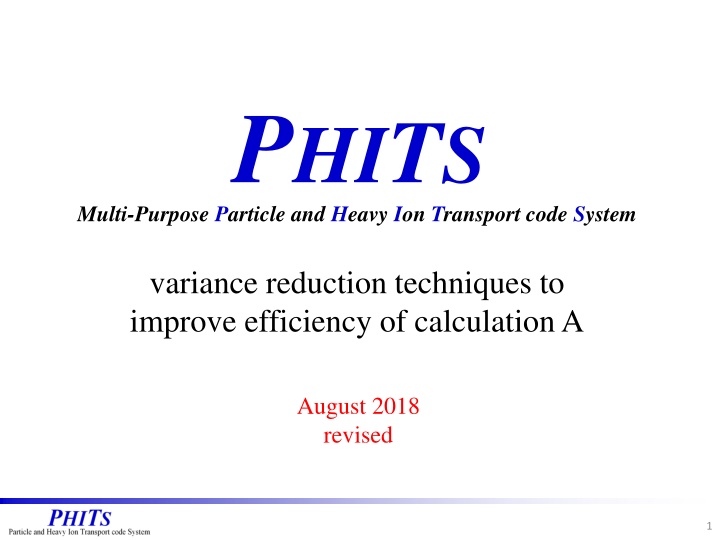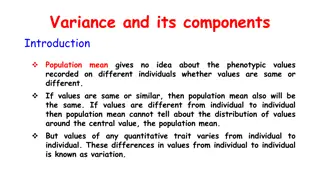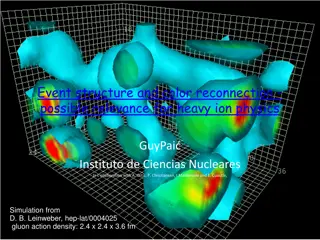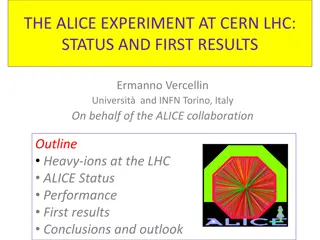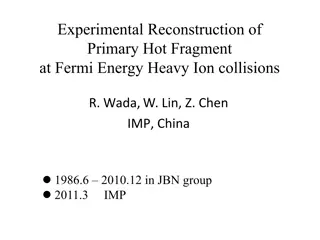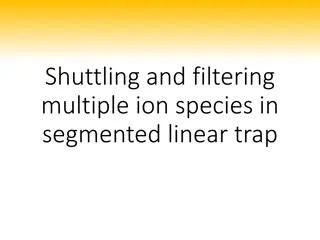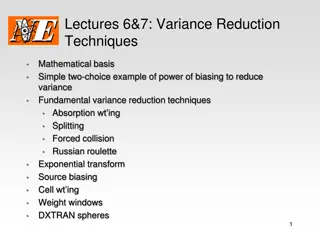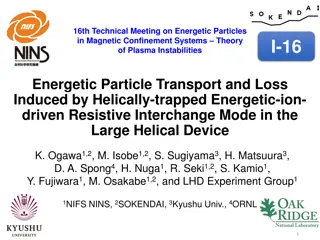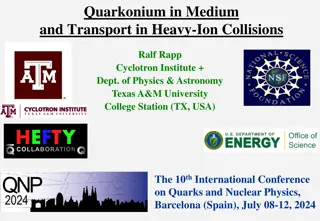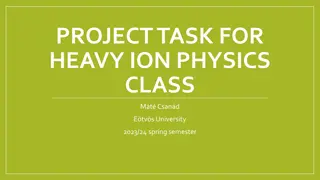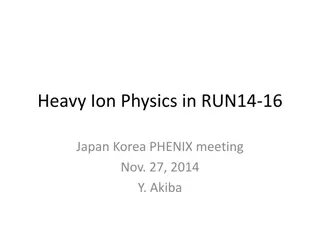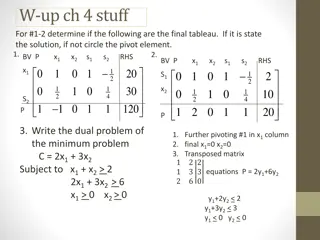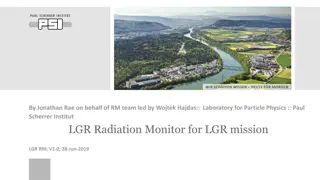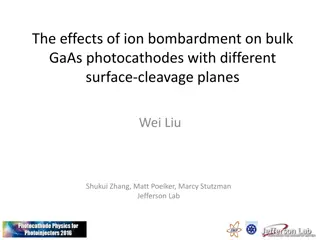Efficiency Enhancement in PHITS: Variance Reduction Techniques for Particle and Heavy Ion Transport
Explore techniques for improving calculation efficiency in the PHITS Multi-Purpose Particle and Heavy Ion Transport code system. Topics covered include neutron deep penetration calculation, effective dose calculation, and use of variance reduction techniques to enhance Monte Carlo simulation efficiency. Learn how to optimize computational time and enhance accuracy in nuclear transport simulations.
Download Presentation

Please find below an Image/Link to download the presentation.
The content on the website is provided AS IS for your information and personal use only. It may not be sold, licensed, or shared on other websites without obtaining consent from the author.If you encounter any issues during the download, it is possible that the publisher has removed the file from their server.
You are allowed to download the files provided on this website for personal or commercial use, subject to the condition that they are used lawfully. All files are the property of their respective owners.
The content on the website is provided AS IS for your information and personal use only. It may not be sold, licensed, or shared on other websites without obtaining consent from the author.
E N D
Presentation Transcript
PHITS Multi-Purpose Particle and Heavy Ion Transport code System variance reduction techniques to improve efficiency of calculation A August 2018 revised 1
Contents of Lecture Introduction Neutron deep penetration calculation [importance] Geometry splitting and Russian Roulette Calculation of particle production in thin target [forced collision] 2
Neutron deep penetration calculation Calculate neutron transport in thick shield and dose rate distribution to depth imp.inp Execute imp.inp and measure computational time Number of history: 1,500 you can find CPU time in phits.out total CPU time . [ P a r a m e t e r s ] icntl = 0 maxcas = 8000 maxbch = 1 ... [ T - T r a c k ] (3rd) mesh = xyz axis = xz z-txt = Effective dose [pSv/source] file = imp-dose-xz.out part = neutron epsout = 1 gshow = 1 Concrete 50cm radius x 180 cm thick cylinder Air 14 MeV neutron multiplier = all mat mset1 all ( 1.0 -202 ) Effective dose is obtained by multiplying neutron fluence by dose conversion coefficient in PHITS. 3
Calculation of effective dose Fluence calculated by [t-track] can be multiplied with several functions that are pre-defined or defined in [multiplier] section Excerpt of data for dose conversion coefficient in /phits/data/multiplier [ T - T r a c k ] (2ndand 3rd) multiplier = all mat mset1 all ( 1.0 -202 ) ID number Dose conversion coefficient pSv cm2 -200 H*(10) -201 Effective dose based on ICRP60 (AP irradiation) Effective dose based on ICRP103 (AP irradiation) Effective dose based on ICRP103 (ISO irradiation) (C k): C normalization factor Source intensity -202 k ID number Dose conversion coefficient -203 Dose with pSv unit is calculated when fluence is normalized by source intensity In this time, source intensity is not used in the normalized factor C. Fluence (1/cm2/source) x Dose conversion coefficient (pSv cm2) = Dose (pSv/source) Please see manual for the [multiplier] section 4
Neutron deep penetration calculation Normal calculation using a single CPU (Intel Core i5-4590 CPU @ 3.30GH ) Number of history= 8,000 total cpu time = 6.39 sec imp-dose-xz.eps Number of history= 500,000 total cpu time = 215.36 sec imp-dose-xz.eps Need to improve the efficiency of Monte Carlo simulation! Use variance reduction techniques 5
Concept of weight in Monte Carlo calculation Example track length tally Li: track length of i-th particle Wi: weight of i-th particle n0: total history number Weight Importance of the particles in Monte Carlo simulation is always 1 in normal calculation* Artificially increase the probability of rare event occurrences. Frequency distribution per a history cannot be calculated, e.g. [t-deposit] with output = deposit, NO MORE event generator! 6 *Not the case for low-energy neutron transport simulation
Contents of Lecture Introduction Neutron deep penetration calculation [importance] Geometry splitting and Russian Roulette Calculation of particle production in thin target [forced collision] 7
Cell Importance Method Set important I to each cell. When a particle passes through the boarder of cell 1 and cell 2, set I2/I1 I2/I1>1: Particle split e.g. I2/I1is integer. I2/I1= 3: Always split into 3 I2/I1is not an integer I2/I1= 2.75: Split into 3 by 75% Split into 2 by 25% I1=1 I2=3 W=1/3 W=1/3 W=1/3 W=1 I2/I1<1: Russian Roulette I1=1 I2=1/3 W=3 1/3 probability killed or alive W=1 2/3 probability killed 7
Check the Trajectory of Single Particle [importance] part = neutron reg imp 10 1 1 1 2 1 Execute imp-hist.inp , and check the neutron trajectory imp-hist.inp Air Concrete R= 20cm Depth = 8cm 2 5MeV Neutron I10=1.0 I1=1.0 I2=1.0 Importance for all cells is set to 1.0 in the default setting imp-trajectory.eps 9
Lets Increase Importance [importance] part = neutron reg imp 10 1 1 2 2 4 imp-hist.inp Reaction occurs here I10=1 I1=2 I2=4 divided into 2 neutrons here imp-trajectory.eps 10
Lets Decrease Importance [importance] part = neutron reg imp 10 1 1 1/2 2 1/4 imp-hist.inp 1/2 neutron survives 1/2 neutron is killed I10=1 I1=1/2 I2=1/4 imp-trajectory.eps 11
Lets Increase Importance EXTREMELY! Particles are divided too much You waste your machine time without improving statistics! [importance] part = neutron reg imp 10 1 1 2 2 100 imp-hist.inp I10=1 I1=2 I2=100 imp-trajectory.eps It is better to set 2~3 for max importance ratio between neighboring cells. A Sample Problem for Variance Reduction in MCNP LA-10363-MS DE86 004380 12
Example of calculation using [importance] Activate the [importance] section in imp.inp , and execute PHITS Ii+1/Ii= 2.5 [importance] part = neutron reg imp 1 2.5**0 2 2.5**1 3 2.5**2 4 2.5**3 5 2.5**4 6 2.5**5 7 2.5**6 8 2.5**7 9 2.5**8 10 2.5**9 11 2.5**10 12 2.5**11 Concrete: 50cm radius x 180 cm thick cylinder, 15cm thick cell x 12 14MeV neutrons with 1cm radius incidence along with z axis total history = 1,500 14 MeV neutron Thickness of 1 cell is 15 cm 13
Example of calculation using [importance] 3.30GHz, single [importance] off total history = 8,000 total cpu time = 6.39 sec Relative error Dose imp-dose-xz_err.eps imp-dose-xz.eps [importance] total cpu time = 48.39 sec 1 Check statistical uncertainty Red:1.0, Yellow: ~0.1, Green: ~0.01 More neutrons penetrate to deeper locations 14
Example of calculation using [importance] 15 With importance Without importance Original data imp-dose-reg.out Dose rate in each cell (15 cm thickness) 15
Important Notice of Setting [importance] Large ratio among cells cause many particle splits. source Good example 16 32 1 8 4 2 Bad example 1 1 8 8 8 32 It is better to set 2~3 for max importance ratio between neighboring cells. Reference: A Sample Problem for Variance Reduction in MCNP LA-10363-MS DE86 004380 16
Bad Example for using [importance] Bad example: Very large importance gap between cell 5 & 6 Let s try a bad example! [importance] part = neutron reg imp 1 2.5**0 2 2.5**0 3 2.5**0 4 2.5**0 5 2.5**0 6 2.5**5 7 2.5**6 8 2.5**7 9 2.5**8 10 2.5**9 11 2.5**10 12 2.5**11 imp-dose-xz.eps imp-dose-xz_err.eps Relative errors are too large in comparison to previous setting! 16
Contents of Lecture Introduction Neutron deep penetration calculation [importance] Geometry splitting and Russian Roulette Calculation of particle production in thin target [forced collision] 18
What is forced collision? Radiation is forced to collide with a very thin target (film). 10 m thick Si 10 m thick Si 100MeV proton with forced collision Proton always collide with Si. without forced collision No collision occurred in such thin target. Example of application Simulation of particle production measurements with a film 19
Simulation of particle production measurements with a film. [t-product]: energy distribution of alpha and Si produced in a target true cross section [t-cross] energy distribution of alpha and Si in a detector measured cross section Without forced collision: protons do not collide with a film. force.inp Let s execute force.inp maxcas = 5000 maxbch = 5 product.eps Radius 0.5cm, 10 m thick Si 100MeV proton detector void cross.eps 20
Forced collision The forced collision is useful for analyzing secondary particles generated from a thin target Split into two particles Weight of uncollided particle Wi exp(- d) d: distance across cell Incoming weight Wi Uncollided particle Weight of collided particle Wi {1-exp(- d)} Collided particle : macroscopic cross section Collide position is decided by cross section at random. Forced collision cell Method of forced collision decreases history variance, but calculation time per history increases. fcl: Forced collision factor (normally, fcl = -1) fcl = -1: applies only to particles entering the cell (weight cut-off is not applied) fcl = 1: applies to all particles surviving weight cutoff (weight cut-off is applied) 21
Lets force particles to collide with a film Tally information in a film at particle production force.inp forced collision [Forced Collisions] off part = proton reg fcl 1 -1.0 Delete off and execute it product.eps Weight of particles produced by forced collision are below weight cutoff, wc2. It is hard to transport secondary particles due to Russian Roulette. track-xz.eps cross.eps 22
How to transport secondaries produced by forced collision? To transport secondaries produced by forced collision, Let s set a small number on weight cutoff, wc2. force.inp [parameters] . wc2(1) = 1.0E-12 # weight cutoff of proton wc2(18) = 1.0E-12 # weight cutoff of Alpha wc2(19) = 1.0E-12 # weight cutoff of Nucleus product.eps Si cross.eps track-xz.eps This experiment can not measure Si production cross sections correctly because many Si are stopped within a target. 23
Summary Cell importance method is effective in deep penetration calculations. Ratios of importance between neighboring cells are better to be less than 3 Appropriate setting of [importance] is very important. It is better to use Weight Window Generator for complicated geometry (weight B). Forced collision method is effective to calculate particle production in a thin target. 24
